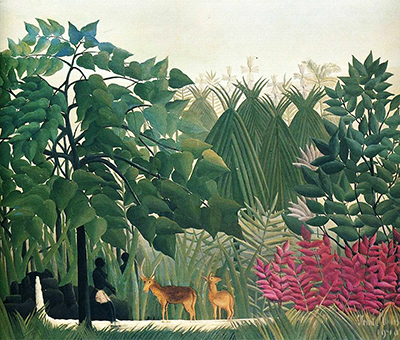Henri Rousseau painted The Waterfall during the final year of his life (1910). With some of the leaves on the tree in the foreground lacking the artist’s signature layers of colour, it is rumoured to be unfinished.
Born in Laval, France in 1844, Rousseau was a self-taught artist who was employed as a customs officer in suburban Paris. Rousseau received no formal art training, therefore his paintings were regarded as ‘primitive’. His work focused on plants and animals; brought to life with patterns, vibrant colours and abundant detail.
During his military service, Rousseau befriended soldiers who had survived the French expedition to Mexico and he listened with great interest to their stories. Their descriptions of the subtropical country were likely to be the inspiration for his exotic landscapes. The vibrancy of Rousseau’s jungle scenes led to the popular misconception that he had travelled to Mexico. In reality, he’d never left France.
Rousseau’s visionary jungle paintings – for which he is most famous – captured the imagination of the art world and after exhibiting with the Fauves in 1905, he gained the admiration of avant-garde artists. His insistence on participating in the exhibitions of the Salon des Independants also paid dividends. Still largely viewed as a curiosity, this naïve, unlearned and unlikely painter was at last starting to get noticed.
Pablo Picasso and the artist Guillaume Apollinaire took a particular interest in Rousseau, seeing in his artwork as something, which his other contemporaries did not. Towards the end of his life, the artist’s exotic themes and bold colours became fashionable. Rousseau instilled a childlike quality in his paintings. His imaginary scenes were informed by visits to the botanical gardens of Paris and from postcards, photographs and illustrated journals. It was to a large part his imagination, which coloured the scenes in his work.




